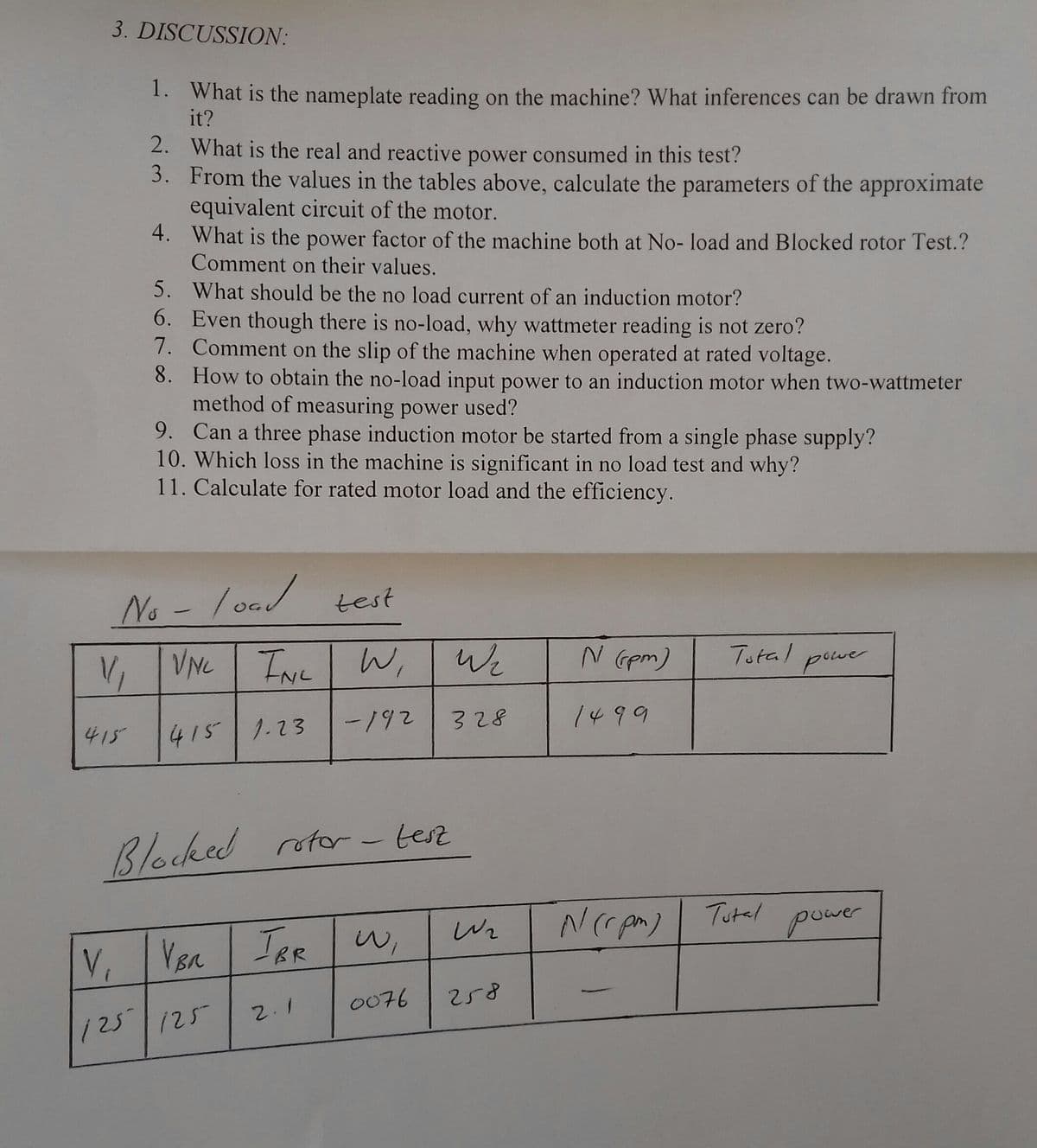1. What is the nameplate reading on the machine? What inferences can be drawn from it?
1. What is the nameplate reading on the machine? What inferences can be drawn from it?
Introductory Circuit Analysis (13th Edition)
13th Edition
ISBN:9780133923605
Author:Robert L. Boylestad
Publisher:Robert L. Boylestad
Chapter1: Introduction
Section: Chapter Questions
Problem 1P: Visit your local library (at school or home) and describe the extent to which it provides literature...
Related questions
Question
Compiling an Electrical Machines laboratory report.
Do take your time if you have to. I have 5 hours.
Kindly find attached documents.

Transcribed Image Text:3. DISCUSSION:
1. What is the nameplate reading on the machine? What inferences can be drawn from
it?
2. What is the real and reactive power consumed in this test?
3. From the values in the tables above, calculate the parameters of the approximate
equivalent circuit of the motor.
4. What is the power factor of the machine both at No- load and Blocked rotor Test.?
Comment on their values.
5. What should be the no load current of an induction motor?
6. Even though there is no-load, why wattmeter reading is not zero?
7. Comment on the slip of the machine when operated at rated voltage.
8. How to obtain the no-load input power to an induction motor when two-wattmeter
method of measuring power used?
9. Can a three phase induction motor be started from a single phase supply?
10. Which loss in the machine is significant in no load test and why?
11. Calculate for rated motor load and the efficiency.
No
o - /oad test
V, VNC TNE
W,
We
N Gpm)
Total powe
pever
-192
328
1499
415
415 1.23
Blocked rotor- test
Tutal
Wr
puwer
V, Vsa TAR w,
0076
258
2.1
125 125

Expert Solution
This question has been solved!
Explore an expertly crafted, step-by-step solution for a thorough understanding of key concepts.
This is a popular solution!
Trending now
This is a popular solution!
Step by step
Solved in 2 steps

Knowledge Booster
Learn more about
Need a deep-dive on the concept behind this application? Look no further. Learn more about this topic, electrical-engineering and related others by exploring similar questions and additional content below.Recommended textbooks for you

Introductory Circuit Analysis (13th Edition)
Electrical Engineering
ISBN:
9780133923605
Author:
Robert L. Boylestad
Publisher:
PEARSON

Delmar's Standard Textbook Of Electricity
Electrical Engineering
ISBN:
9781337900348
Author:
Stephen L. Herman
Publisher:
Cengage Learning

Programmable Logic Controllers
Electrical Engineering
ISBN:
9780073373843
Author:
Frank D. Petruzella
Publisher:
McGraw-Hill Education

Introductory Circuit Analysis (13th Edition)
Electrical Engineering
ISBN:
9780133923605
Author:
Robert L. Boylestad
Publisher:
PEARSON

Delmar's Standard Textbook Of Electricity
Electrical Engineering
ISBN:
9781337900348
Author:
Stephen L. Herman
Publisher:
Cengage Learning

Programmable Logic Controllers
Electrical Engineering
ISBN:
9780073373843
Author:
Frank D. Petruzella
Publisher:
McGraw-Hill Education

Fundamentals of Electric Circuits
Electrical Engineering
ISBN:
9780078028229
Author:
Charles K Alexander, Matthew Sadiku
Publisher:
McGraw-Hill Education

Electric Circuits. (11th Edition)
Electrical Engineering
ISBN:
9780134746968
Author:
James W. Nilsson, Susan Riedel
Publisher:
PEARSON

Engineering Electromagnetics
Electrical Engineering
ISBN:
9780078028151
Author:
Hayt, William H. (william Hart), Jr, BUCK, John A.
Publisher:
Mcgraw-hill Education,